Dodge Coronet
The Coronet is an automobile that was marketed by Dodge as a full-size car in the 1950s, initially the division's highest trim line, but[1] starting in 1955, the lowest trim line. From the 1965 to 1975 model years the name was on intermediate-sized models. A coronet is a small crown consisting of ornaments fixed on a metal ring.
| Dodge Coronet | |
|---|---|
_(cropped).jpg) 1968 Dodge Coronet R/T | |
| Overview | |
| Manufacturer | Chrysler Corporation |
| Production | 1949–1959 1965–1976 |
| Body and chassis | |
| Class | Full-size (1949–1959) Mid-size (1965–1976) |
| Layout | FR layout |
| Chronology | |
| Successor | Dodge Monaco |
First generation (1949–1952)

| First generation | |
|---|---|
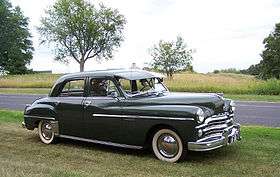 1949 Dodge Coronet 4-Door Sedan | |
| Overview | |
| Production | 1949–1952 |
| Assembly | Dodge Main Factory, Hamtramck, MI |
| Body and chassis | |
| Body style | 2-door coupe 2-door hardtop 4-door sedan 4-door limousine (8 passenger) 4-door station wagon |
| Related | DeSoto Custom |
| Powertrain | |
| Engine | 230 cu in (3.8 L) 103hp I6[2] |
| Transmission | 2-speed automatic 3-speed manual "Gyromatic or Fluid drive" |
| Dimensions | |
| Wheelbase | 123.5 in (3,137 mm)[3] |
| Length | 203.6 in (5,171 mm) (1949)[2] 202.8 in (5,151 mm) (1950)[2] |
| Width | 74"[2] |
1949
The Dodge Coronet was introduced with the division's first postwar body styles. Lower trim lines were the Wayfarer and Meadowbrook, with the Wayfarer being built on a shorter 115 inch wheelbase.[4] The only engine for Dodge was a 230-cubic-inch (3,800 cc) flat-head straight six cylinder engine with a single barrel Stromberg carburetor, producing 103 hp (77 kW) (gross). The stock Dodge Coronet was a smooth running car, and the six-cylinder engine could power the car to 90 mph (145 km/h)+ . A limited production model was a four-door, eight-passenger limousine, an extended version of the stock Dodge Coronet.[4] One of the most notable features of the first-generation Coronet was a three-speed, fluid-driven transmission that was operated by a foot pedal on the floor. It required no shifter. It had full instrumentation and 37 inches of head room both front and rear.[5][6]
1950
Dodge received a facelift for 1950 but like the 1949 models were still divided into Wayfarer, Meadowbrook and Coronet lines. The 1950 models can be identified easily by the new grille design which featured 3 heavy horizontal bars. The upper and lower bars formed a stylish oblong shape. Within this oblong grille was a thick center bar with parking lights on each end and a large chrome plaque in the center bearing the Dodge crest. The 8-passenger sedan's length was 216.8 inches.[2]
1951–1952
.jpg)
.jpg)
Dodge received yet another facelift in 1951 but this time the cars remained virtually unchanged for two model years. Busy manufacturing military vehicles for use in Korea, they chose not to dedicate valuable resources to completely redesign civilian vehicles. Still divided into Wayfarer, Meadowbrook and Coronet lines through 1952, by 1953 the Wayfarer line had been discontinued. The grille of the 1951 model was similar in shape to the 1950 grille, but with the elimination of the thick vertical center bar and the addition of six vents running horizontally between the top and center bars, a whole new look was achieved. The Coronet Diplomat was Dodge's first hardtop-convertible, featuring a pillarless steel roof styled after the contemporary Chrysler Newport. The speedometer was now circular, and the other four gauges were rectangles.[2] For 1952 the Coronet had a painted lower grille louver.
Second generation (1953–1954)
| Second generation | |
|---|---|
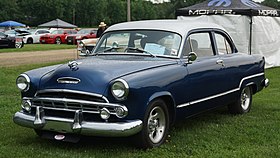 1953 Dodge Coronet 2-door coupe | |
| Overview | |
| Model years | 1953–1954 |
| Assembly | Dodge Main Factory, Hamtramck, MI |
| Body and chassis | |
| Body style | 4-door sedan 2-door coupe 2-door station wagon |
| Related | DeSoto Fireflite |
| Powertrain | |
| Engine | 241 cu in (3.9 L) V8 230 cu in (3.8 L) I6 |
| Transmission | 2-speed automatic 3-speed manual Gyrol fluid Drive Gyro-Torque Drive[2] |
| Dimensions | |
| Wheelbase | 119 in (3,023 mm)[2] |
| Length | 201.4 in (5,116 mm)[2][7] |
1953
.jpg)
For 1953, the Coronet was totally redesigned.[2] It gained an optional 241 cu in (3.9 L) "Red Ram"[8] Hemi Engine and set over 100 land speed records at the Bonneville Salt Flats.[9] The windshield finally became one-piece.[2] Electric windshield wipers were standard, while the radio cost $83.[2]
1954
The Dodge Royal line was added above the Coronet in 1954. Dodge was putting more luxury into all of its models which included the Meadowbrook, Coronet and new Royal lines. Still, styling changes for 1954 were modest. The chrome molding on the hood lip was wider than on the 1953 models and a large chrome upright in the center of the grille replaced the five vertical dividers used previously. It still came with full instrumentation.[10] 1954 saw Chrysler's first fully automatic transmission, two-speed PowerFlite, offered as an extra-cost option on all Dodges.
Third generation (1955–1956)
- See also 1955 Dodge
.jpg)

The 1955 Coronet dropped to the lower end of the Dodge vehicle lineup, with the Wayfarer and Meadowbrook names no longer used and the Custom Royal added above the Royal, Lancer, and La Femme. Bodies were restyled with help from newly hired Virgil Exner to be lower, wider, and longer than the lumpy prewar style, which in turn generated a healthy boost in sales over 1954. Power came from either a 230 cu in (3.8 L) Chrysler Flathead engine straight-6, now producing 123 hp (92 kW) Two V8 engines were offered: 270 cu in (4.4 L) Polyspheric (poly or semi-hemi) heads producing 175 hp (130 kW) and a 315 cu in (5.2 L) (the "Hemi")
Power windows were new.[11] Wheelbase was 120 inches. They were 212.1 inches long.[12] A number of trim lines were available:
- 2- or 4-door station wagon — The Coronet wagon used the Suburban name and had the V8 or six
- hardtop coupé — The V8 Coronet Lancer
- 2- or 4-door sedan — V8 or Six
- 2-door sedan — V8 or Six
- 4-door, eight-passenger limousine
1956 (:See also Plymouth Fury) was the last year of this body style before the change in 1957, the only differences offered in 1956 from the previous year were trim packages and the new Dodge D-500. The D-500 was the first Dodge factory high performance made in honor of the (D-500-1) "Super Stock" model with the only external clues being discreet crossed checkered flags and "500" lettering on its hood and lower rear deck it was also available for order from the dealer on Coronet models, including station wagons and two-door sedans. The standard D-500 trim included a 315 cu in (5.2 L) V8 with hemispherical heads (unlike other Dodge V8s ( List of Chrysler engines) which used Polyspheric heads), a unique camshaft, valve lifters, pushrods, carburetor, ignition, and pistons. With a compression ratio of 9.25:1, four-barrel Carter WCFB carburetor, and dual-point distribution, peak horsepower was 260 bhp (190 kW) while torque was a solid 330 lb⋅ft (450 N⋅m). The D-500 also received an upgraded suspension with stiff front coil springs; heavy duty Oriflow shock absorbers, with the same valving specified for Dodge police cars, were mounted in the springs. Similar units were used in the rear. Overall height of the D-500 was 1.5 inches (38 mm) lower than its standard Dodge counterpart. The D-500 came standard with 15x5.5 inch wheels with 7.60x15 inch tubeless tires. New for safety were safety door locks.[13] The D-500-1 (the first 500 made required by NASCAR, was intended for NASCAR competition. The D-500-1 had an even stiffer suspension than the D-500. Under the hood, the engine received larger valves (about 18% larger), a full-race camshaft, and a double log intake manifold that used two four-barrel Carter WCFB carburetors and a shaved deck for 8.25:1 compression. This all added up to 285 bhp (213 kW). It was the fastest car that year from the factory.
Fourth generation (1957–1959)
.jpg)

The 1957 model year debuted a new D-501, which replaced the D-500 from the year before as the top Coronet. The D-501 received Chrysler's proven 354 cu in (5.8 L) Hemi V8, which were actually left over engines from the 1956 Chrysler 300B production. Camshafts from the 1957 Chrysler 392 cid engines were installed in the 354 V8s. A pair of Carter four barrel carburetors fed the 10.0:1 compression ratio to produce 340 bhp (250 kW). Other changes included the addition of the Torsion-Aire Ride (torsion bar) front suspension[2] and a heavy duty suspension with heavy duty shock absorbers and a heavy duty leaf sprung rear. A 3.73:1 rear axle was standard with the three-speed manual transmission, but automatic cars received a 3.18:1 rear axle. There were 13 optional rear axles available, ranging from 2.92:1 through 6.17:1. The D-501 received 7.60x15 tires on 15x8 inch wheels. Brakes were 12-inch (300 mm) diameter drums. Only 101 D-501s were produced. A padded dash was optional.[14]
In the September 1957 issue of Popular Mechanics, owners of both the Coronet six-cylinder and eight-cylinder were surveyed.[15] Many people (37.6% of I6 owners and 34.8% of V8 owners) complained that there were too many water leaks. When PM tested a V8 Coronet for water resistance, water got into the engine and pooled in "two spark plug wells" which had to be siphoned out before the engine could run with all cylinders again.[16] However, many did like the exterior styling and the ride comfort. 0-60mph on 90 octane gasoline was 12.3 seconds.
The 1958 and 1959 Coronet, Royal, and Custom Royal used a DeSoto Fireflite chassis but had less ornate trim. Power came from the 230 cu in (3.8 L) "Getaway" L-head straight-6 or the 325 cu in (5.3 L) "Red Ram" V8. In 1959 a Silver Challenger model was also offered on the Coronet line. This was a six-cylinder or V-8 model available only in silver paint and only on a two-door body. It came with many extra features at no cost, such as wall-to-wall deep pile carpeting, premium white wall tires and wheel covers, luxury fabrics and upgraded interior and electric windshield wipers.[17] The overall length was increased to 217.4 inches.[2]
The Dodge Custom Royal was also assembled by Chrysler Australia from early 1958 to 1960.[18]
A Dodge Coronet was the only known example of the JATO Rocket Car legend. To publicize Dodge's 'total contact' front dual-leading shoe drum brakes a JATO unit was fitted to a 1958 Coronet and driven at speed across the El Mirage dry lake. This TV advertisement was broadcast during Dodge-sponsored Lawrence Welk Show.[19]
1959 Dodge Silver Challenger
| Dodge Silver Challenger | |
|---|---|
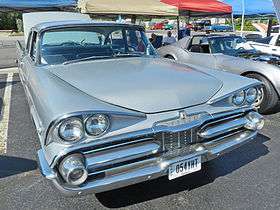 | |
| Body and chassis | |
| Class | Full-size car |
| Body style | 2-door sedan |
| Related | Dodge Coronet (fourth generation) |
The first car that carried the Challenger name was introduced as the limited edition Dodge Silver Challenger Club Sedan, an addition to the 1959 full-sized Dodge Coronet (fourth generation) model line produced in Detroit, Michigan.[20]
The Silver Challenger came only in silver paint and exclusively on Chrysler's 217.4 in (5,520 mm) long two-door, on a 122 in (3,100 mm) wheelbase. It was available with either the 230 cu in (3.8 L) "Getaway" L-head straight-six engine for $2,297, or the 326 cu in (5.3 L) "Red Ram" V8 for $2,408.[21] This car was marketed for the spring selling season to "new-car buyers who've been waiting to get the most for the least."[22] A column-shifted three-speed manual transmission was standard and an automatic was optional.
The 1959 Silver Challenger was marketed with extra features at no extra cost. These included premium white wall tires, full wheel covers, electric windshield wipers, as well as an upgraded interior with silver metallic vinyl and black "Manchu" fabric upholstery, dual arm rests and sun visors, as well as deep pile wall-to-wall carpeting.[22][23]
Fifth generation (1965–1970)
1965–1967
| Fifth generation | |
|---|---|
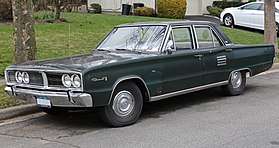 1966 Dodge Coronet 500 SE | |
| Overview | |
| Production | 1965–1970 |
| Assembly | Hamtramck, Michigan, United States Los Angeles Assembly, Maywood, California Bogotá, Colombia |
| Body and chassis | |
| Body style | 4-door wagon (1965-70) 4-door sedan (1965-70) 2-door sedan (1965-67) 2-door coupe (1968-70) 2-door hardtop (1965-70) 2-door convertible (1965-70) |
| Platform | B-body |
| Related | Plymouth Belvedere Plymouth Savoy Dodge Charger Plymouth GTX Plymouth Road Runner |
| Powertrain | |
| Engine | 225 cu in (3.7 L) Slant-6 I6 273 cu in (4.5 L) LA V8 318 cu in (5.2 L) A V8 318 cu in (5.2 L) LA V8 361 cu in (5.9 L) B V8 383 cu in (6.3 L) B "Magnum" V8 426 cu in (7.0 L) Hemi V8 440 cu in (7.2 L) RB "Magnum" V8 |
| Transmission | 3-speed manual 4-speed manual 3-speed automatic |
| Dimensions | |
| Wheelbase | 116.0 in (2,946 mm) Wagon: 117.0 in (2,972 mm) |
| Length | 209.7 in (5,326 mm) |
The Coronet reappeared for the 1965 model year as the intermediate sized B-body using a 117-inch wheelbase, continuing what had been the Dodge Polara, which was once again full-size. For 1965, Dodge sold slightly over 209,000 units, making the Coronet the most popular model sold by Dodge that year. Trim levels initially were base Coronet including a Deluxe version, Coronet 440 and Coronet 500.
The base Coronet and Deluxe were available as two-door sedans, four-door sedans and station wagons. For 1965 only, Dodge also sold only 101 units of a modified wheelbase version of the base Coronet two-door sedan and 440 hardtop used for NHRA drag racing. The model known as A990 came with a racing version of the 426 Hemi engine. The car A990 was stripped of all features and included lightweight base bucket seats from Dodge's A100 truck/van line of vehicles. These altered wheelbase vehicles eventually became popularly known as "funny cars" due to their unique wheel spacing. The front and rear axles were moved forward significantly from the stock location, putting the front wheels directly behind the front fender, and the rear wheels almost under where the rear seat would normally go; this alteration transferred weight to the rear tires, increasing traction on launch. From the popular term "funny cars" was born an entire genre of racing vehicles, which exists to this day (albeit in much transformed form). Front seat belts and padded dash were standard.[24]
The middle of the Coronet line-up was the 440 and was available as a two-door hardtop, convertible or station wagon. The 440 designation did not indicate engine displacement as commonly assumed (both then and now, which helped sales to an extent). The nomenclature was a carryover theme from the 1963–64 Polara series. The top of the Coronet line-up was the Coronet 500 and was available only as a two-door hardtop or convertible in 1965. Slightly over 33,300 units were sold in 1965 and included as standard, a V8 engine (273 cubic inches), exterior trim and badging, bucket seats, padded dash and chrome floor console. Coronets were manufactured at Chrysler's Los Angeles assembly plant and at Lynch Road assembly plant in Detroit and ST. Louis plant in Missouri. Engines offered for 1965 included the base 225 Slant-Six, 273, 318 (Polyhead), 361 (the last year for this big block engine was 1966), 383 and 426 in multiple HP choices ( the 383 came in a special version rated at 330 HP). Sales brochures list the 413 (its last year offered) as available, but no records exist of this engine, commonly used in Imperials, being installed in Coronets for 1965.[25] A tachometer was optional.[26]
In 1966 a four-door Coronet 500 was added, called the Coronet 500 SE (Special Edition). It had special "SE" logos on the C-pillars and on the seat back.[27] There would be no Coronet 500 wagon until 1968. Coronet received a redesign in 1966, and a facelift in 1967. Trim levels initially were base Coronet, Coronet 440 and Coronet 500. In 1966, the Coronet Deluxe was introduced, fitting between the base Coronet and the Coronet 440. The Coronet R/T was introduced in 1967.
The Coronet R/T was available as a two-door hardtop or convertible. Standard engine was Chrysler's largest, the 440-cid V-8, it was tweaked to 375 bhp and christened the Magnum. The only engine option was the 426-cid Hemi, now in its second year in "Street" trim and again rated at 425 bhp. It added $908. Transmission choices were Mopar's excellent heavy-duty three-speed TorqueFlite automatic or a four-speed manual.
When the 426ci Hemi was made available to the general public for the 1966 model year, it could be ordered in any Coronet model or trim level. No Hemi-powered Coronet wagons have been verified, but a few Coronet Deluxe four-door sedans are known to exist. A total of just 136 Coronet 500 Street Hemis were built for 1966.[28] Beginning in 1967, Chrysler decided that the Hemi should be available only in their badged muscle cars: the Dodge Charger and Coronet R/T and the Plymouth Belvedere GTX. The top engine option for the rest of the Coronet line was supposed to be the 383-ci, 4-barrel V8. Despite this, some Hemi-powered 1967 Coronet Deluxe two-door sedans were produced. There is also one Hemi-powered 1967 Coronet 440 two-door hardtop known, and One Hemi-powered 1967 Coronet 500 two-door hardtop known, which is not among the 55 WO23 Super Stock cars produced for Dodge drag racers.
1968–1970
The Coronet and similar Plymouth Belvedere received complete redesigns in 1968, as did the Dodge Charger, which shared the B-body platform. There was a mild facelift in 1970. Trim levels initially included the base Coronet, Coronet Deluxe, Coronet 440, Coronet 500 and Coronet R/T. The Coronet Super Bee was introduced in early 1968 as a companion to the Plymouth Road Runner. In keeping with Dodge's position as a step above Plymouth, the Super Bee shared the Charger's Rallye instrument cluster and the Coronet 440's rear finish panel.
As in 1967, the 440ci RB V8 was only available in the Coronet R/T in 1968. The 426ci Hemi V8 was supposed to be limited to the R/T and Super Bee, but two 1968 Coronet 440s are known to have been built with this engine.
In mid-1969, the A12 package was introduced on the Super Bee. It included a 390 hp (291 kW) version of the 440 with three 2bbl Holley carburetors on an aluminum intake manifold, a black fiberglass lift-off hood secured with metal pins, heavy-duty suspension and 15" steel wheels with no hubcaps or wheel covers. The hood had an integrated forward-facing scoop which sealed to the air cleaner assembly and bore a decal on each side with the words "SIX PACK" in red letters, "Six Pack" being the name used for the 6-bbl induction setup when installed on a Dodge (Plymouth went with "440 6bbl" on the A12 Road Runners). The A12 Super Bee could be had with most Super Bee options, with the exception of air conditioning and tire-wheel packages. The A12 option was a 1969-only package, but the 440 6bbl returned in 1970 as an optional engine on both the Super Bee and the Coronet R/T.
The base Coronet and Deluxe were available as 2-door coupes, 4-door sedans or station wagons. The base Coronet was dropped in 1969, leaving the Deluxe as the lowest trim level through 1970. The Coronet 440 convertible was dropped for 1968, but a 2-door coupe was added along with the 2-door hardtop, 4-door sedan and station wagon. This would remain the lineup through 1970. Coronet 500 retained its 2-door hardtop, convertible and 4-door sedan through 1970. A Coronet 500 station wagon made its debut in 1968, continuing through 1970. Simulated woodgrain trim was standard on the Coronet 500 wagon.
The Coronet R/T 2-door hardtop and convertible continued through 1970.
The Super Bee was only available as a 2-door coupe or 2-door hardtop. Chrysler did display a convertible with Super Bee stripes at car shows in 1968, but never offered it as a production model. Some enthusiasts have created "phantom" Super Bee convertibles by adding the appropriate trim and stripes to Coronet 500 convertibles.
The Dodge Super Bee was a limited production muscle car from Dodge division produced from 1968–1971. The original Super Bee was based on the Dodge Coronet, a 2-door model only and was produced from 1968–1970. It was Dodge’s low-priced muscle car, the equivalent to Plymouth Road Runner, and was priced at $3,027. Available with Hemi engine, this option increased the price by 33% so only 125 models were sold with this engine option. The Super Bee included a heavy-duty suspension, an optional Mopar A-833 four-speed manual transmission, with high performance tires, and a stripe (with the bee logo) wrapped around the tail. The name "Super Bee" was derived from the "B" Body designation given Chrysler's mid size cars which included the Coronet.
A “six-pack” (three two-barrel carburetors) version of the 440 engine was added to the list mid-year. This engine was between the standard engine and the Hemi as a $463 option. The 1969 model year gave customers several engines to choose from, the base 383 hp (high performance), 440 six pack, and the 426 Hemi V8. The 440 Magnum (4bbl) was not available as an option, it was reserved for the Coronet R/T.
In 1970, the Super Bee was given a different front end look that consisted of a dual ovaled grill that was referred to as “bumble bee wings”. Despite the new looks, the engines, as well as the “ramcharger” hood (that carried over from 1969 model), sales plummeted for the 1970 model. In 1970, Dodge also produced four Super Bee convertibles; the whereabouts of the four cars are unknown.
 1966 Dodge Coronet 440 2-door hardtop
1966 Dodge Coronet 440 2-door hardtop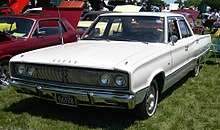 1967 Dodge Coronet four-door sedan
1967 Dodge Coronet four-door sedan 1968 Dodge Coronet 500
1968 Dodge Coronet 500 1969 Dodge Coronet Super Bee
1969 Dodge Coronet Super Bee.jpg) 1970 Dodge Coronet Super Bee
1970 Dodge Coronet Super Bee
Sixth generation (1971–1974)
| Sixth generation | |
|---|---|
.jpg) 1974 Dodge Coronet Custom 4-Door Sedan | |
| Overview | |
| Production | 1971–1974 |
| Assembly | Hamtramck, Michigan, United States |
| Body and chassis | |
| Body style | 4-door wagon 4-door sedan |
| Related | Plymouth Belvedere Plymouth Savoy Plymouth Satellite Dodge Charger Plymouth GTX Plymouth Road Runner |
| Powertrain | |
| Engine | 225 cu in (3.7 L) Slant-6 I6 318 cu in (5.2 L) 318 LA V8 383 cu in (6.3 L) B "Magnum" V8 400 cu in (6.6 L) B V8 440 cu in (7.2 L) RB "Magnum" V8 |
| Transmission | 3-speed manual 3-speed automatic 4-speed manual |
| Dimensions | |
| Wheelbase | 118.0 in (2,997 mm)[29] |
| Length | Sedan: 207.0 in (5,258 mm) Wagon: 213.4 in (5,420 mm)[29] |
| Width | Sedan: 77.7 in (1,974 mm) Wagon: 56.4 in (1,433 mm) |
| Height | Sedan: 53.7 in (1,364 mm) Wagon: 63.4 in (1,610 mm) |
The new Coronet was a twin of the four-door Plymouth Satellite and featured more flowing styling. It was offered only as a sedan and wagon, the related and also restyled Dodge Charger covering the coupe market. Slight alterations of the front grille, headlights, and taillights followed in 1972. Sales of the Coronet were fairly low from this point onwards, with around 80–90,000 produced each year through 1973 (compared with 196,242 as recently as 1968), due both to the fuel crisis and to a proliferation of Dodge and Plymouth models, and the growing effect of overlap with the other Chrysler Corporation brands.[30] In addition to the usual changes in grille, lights, and interior, Dodge introduced its "TorsionQuiet" system of additional silencers and rubber vibration insulators, providing a much smoother ride and a quieter interior.
The front and rear fascias were redesigned, most notably the rear bumper, which met the 1974 DOT requirements. The sedan bodystyle would be the basis of the later Coronets (and its twin, the Plymouth Fury) until the 1978 model year.
.jpg) 1972 Dodge Coronet Custom sedan
1972 Dodge Coronet Custom sedan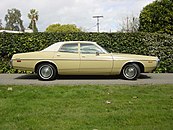 1973 Dodge Coronet Custom sedan
1973 Dodge Coronet Custom sedan.jpg) 1974 Dodge Coronet Custom 4-Door Sedan
1974 Dodge Coronet Custom 4-Door Sedan
Seventh generation (1975–1976)
| Seventh generation | |
|---|---|
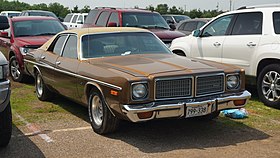 | |
| Overview | |
| Production | 1975–1976 |
| Assembly | Hamtramck, Michigan, United States |
| Body and chassis | |
| Body style | 4-door wagon (1975-76) 4-door sedan (1975-76) 2-door hardtop/coupe (1975 only) |
| Related | Plymouth Fury |
| Powertrain | |
| Engine | 225 cu in (3.7 L) Slant-6 I6 318 cu in (5.2 L) LA V8 360 cu in (5.9 L) LA V8 400 cu in (6.6 L) B V8 440 cu in (7.2 L) RB V8 (Police) |
| Transmission | 3-speed manual 3-speed automatic 4-speed manual |
| Dimensions | |
| Wheelbase | Sedan & Wagon: 118.0 in (2,997 mm)[31] Coupe: 115.0 in (2,921 mm) |
| Length | Sedan: 217.9 in (5,535 mm) Coupe: 213.8 in (5,431 mm) Wagon: 225.6 in (5,730 mm) |
| Width | Sedan: 77.7 in (1,974 mm) Coupe: 77.4 in (1,966 mm) Wagon: 79.2 in (2,012 mm) |
| Height | Sedan: 53.9 in (1,369 mm) Coupe: 52.6 in (1,336 mm) Wagon: 56.5 in (1,435 mm) |
1975
In 1975, the cars received a refreshening with the body appearing squarer and after a four model year absence since the close of the 1970 model year, the Dodge Coronet 2-door model returned for just the 1975 model year only, it also would share a lot in common with the Dodge Charger Sport 2-door model, which would appear for just the following model year only. The front fascia was redesigned with two round dual beam headlights, which was shared with its then-concurrent Plymouth Fury counterpart.
1976
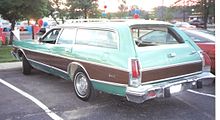
1976 was the final model year for the Dodge Coronet, at least so far as the name Coronet went, also its body style choices were relegated to just only two four-door models, the four-door wagon and the four-door sedan. The former Dodge Coronet 2-door model, which appeared for just the previous model year only was replaced by the Dodge Charger Sport 2-door model, which, itself, appeared for only one model year. During the next model year (1977), the mid-size Dodge Coronet would be renamed Monaco, which would be given stacked rectangular headlights and other minor cosmetic changes, that would provide a prompt sales boost, also, during that same model year, the full-size Dodge Monaco would be renamed Dodge Royal Monaco, which would appear for just one model year only and after that, both Dodge and Plymouth (which would include Dodge Royal Monaco's entire Plymouth Gran Fury counterpart line up as well) would discontinue all production of any more full-size models. During the following model year (1978), the mid-size Dodge Monaco (which would include its entire Plymouth Fury counterpart line up as well) would make its final appearance (for all during the remainder of the 1970s).
Eighth generation (1980s)
Dodge Coronet was used as a name for the Colombian-market Dodge Diplomat.
References
- Notes
- https://www.allpar.com/cars/dodge/coronet.html
- Flory, Jr., J. "Kelly" (2008). American Cars, 1946–1959 Every Model Every Year. McFarland. ISBN 978-0-7864-3229-5.
- Ristic-Petrovic, Dusan. "1949 Dodge foldout". Old Car Brochures.com. Retrieved November 20, 2011.
- Godshall, Jeffrey I. (1980). "Wayward Wayfarer: The story of a Dodge". Automobile Quarterly. XVIII (1): 77. ISSN 0005-1438.
- "1949 Dodge D29 D30 manual". Old Car Brochures.com. p. 4. Retrieved January 3, 2016.
- http://oldcarbrochures.com/static/NA/Dodge/1949_Dodge/1949%20Dodge-2/image2.html
- "1953 Dodge Brochure". Old Car Brochures.com. Retrieved November 20, 2011.
- "1954 Dodge brochure". Old Car Brochures.com. p. 12. Retrieved January 3, 2016.
- https://www.allpar.com/cars/dodge/coronet.html
- "1954 Dodge Owners Manual". Old Car Brochures.com. Retrieved November 20, 2011.
- "1955 Dodge brochure". Old Car Brochures.com. Retrieved November 20, 2011.
- "1955 Dodge brochure". Old Car Brochures.com. p. 7. Retrieved January 3, 2016.
- "1956 Dodge full line folder". Old Car Brochures.com. Retrieved January 3, 2016.
- "1957 Dodge brochure". Old Car Brochures.com. Retrieved November 20, 2011.
- Popular Mechanics. September 1957. Retrieved 17 February 2019.
- Popular Mechanics. September 1957. Retrieved 17 February 2019.
- "1959 Dodge". Los Angeles Times. Retrieved March 23, 2011.
- Farmer, Gavin (2010). Great ideas in motion: Chrysler's Australian history 1946–1981. Bridgewater, South Australia: Ilinga Books. p. 74 & 412. ISBN 978-0-98052-291-4.
- Dodge presents The Lawrence Welk Show on YouTube, segment begins at 30:00
- Erickson, Keith (April 25, 2014). "Hooniverse Obscure Muscle Car Garage – The 1959 Dodge Silver Challenger". Hooniverse. Archived from the original on August 28, 2017. Retrieved August 27, 2017.
- Gunnell, John (2004). Standard guide to 1950s American cars. KP Books. p. 96. ISBN 978-0-87349-868-5. Retrieved July 13, 2014.
- soiouz (14 February 2010). "1959 Dodge mid-year Silver Challenger edition". forwardlook.net. Retrieved July 13, 2014.
- "1959 Dodge Silver Challenger (Dodge Public Relations)" (Press release). challengertalk.com. Archived from the original on October 8, 2013. Retrieved July 13, 2014.
- Ristic-Petrovic, Dusan. "1965 Dodge full line". Old Car Brochures.com. p. 13. Retrieved November 20, 2011.
- Collectible Automobile, April 2010
- "1966 Dodge brochure". Old Car Brochures.com. Retrieved November 20, 2011.
- Schild, Jim (2004). Original Dodge and Plymouth B-Body Muscle 1966-1970. MotorBooks International. p. 25. ISBN 978-0-76031-860-7.
- Hot Rod, 7/90, p. 93.
- "1972 Dodge Coronet brochure". Old Car Brochures.com. Retrieved November 20, 2011.
- "Dodge Coronet cars". Allpar.com. Retrieved February 1, 2007.
- "1974 Dodge full-line_brochure". Old Car Brochures.com. Retrieved November 20, 2011.
- Bibliography
- Gunnell, John, ed. (2004). The Standard Guide to 1950s American Cars. Krause Publications. ISBN 0-87349-868-2.
- "Dodge Coronet cars". Allpar.com. Retrieved January 25, 2007.
- "Dodge Coronet History". Muscle Car Club.com. Retrieved July 28, 2006.
External links
![]()
- Quatro Rodas. Clássicos: Dodge Coronet, nobreza soberana (in Portuguese)